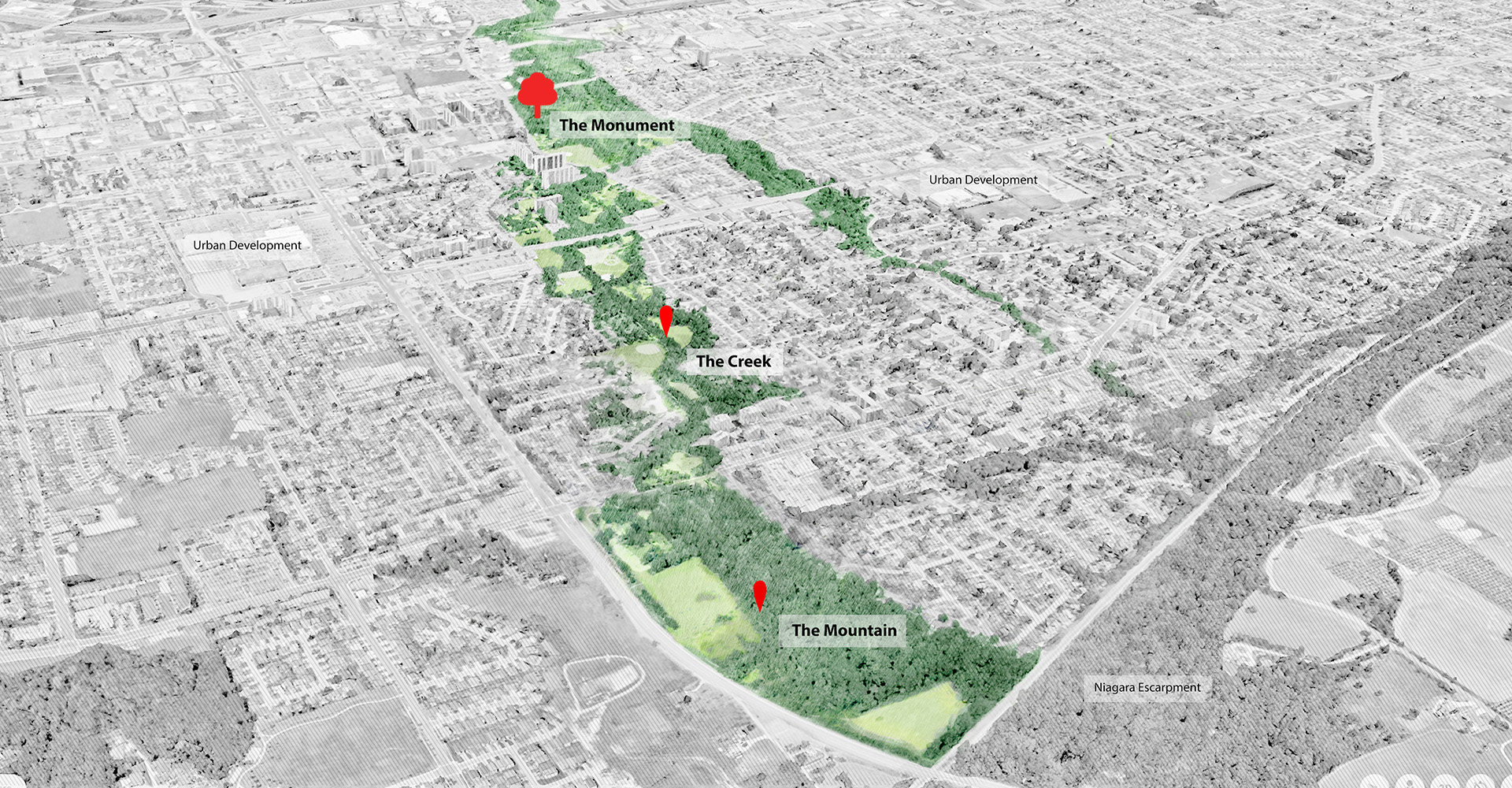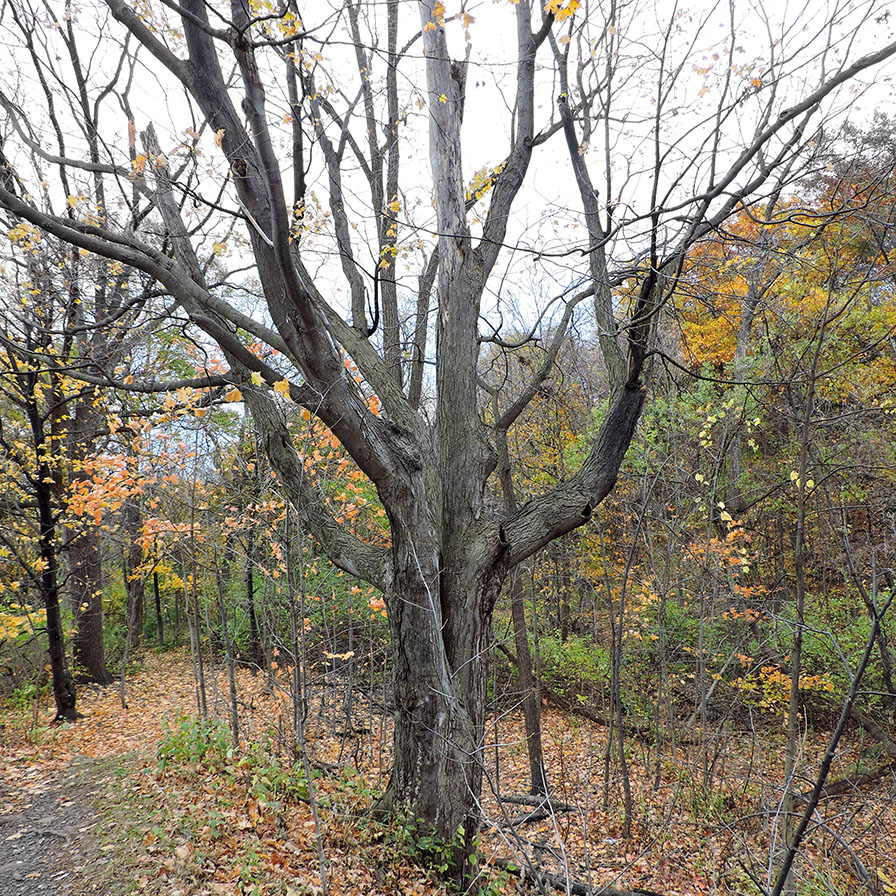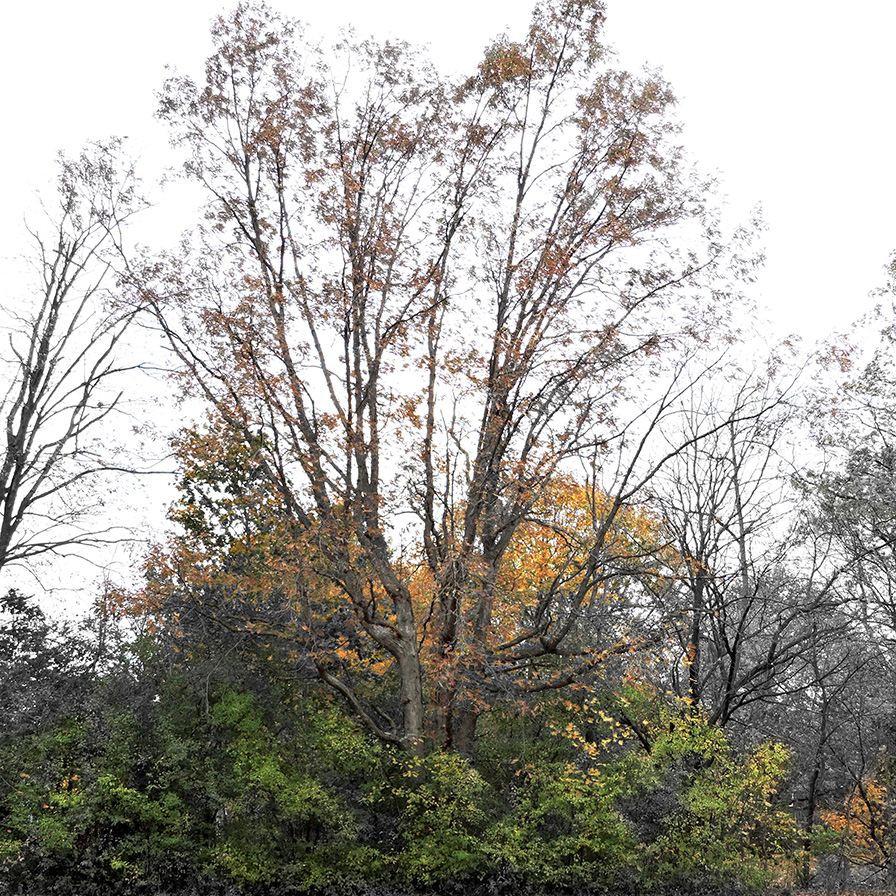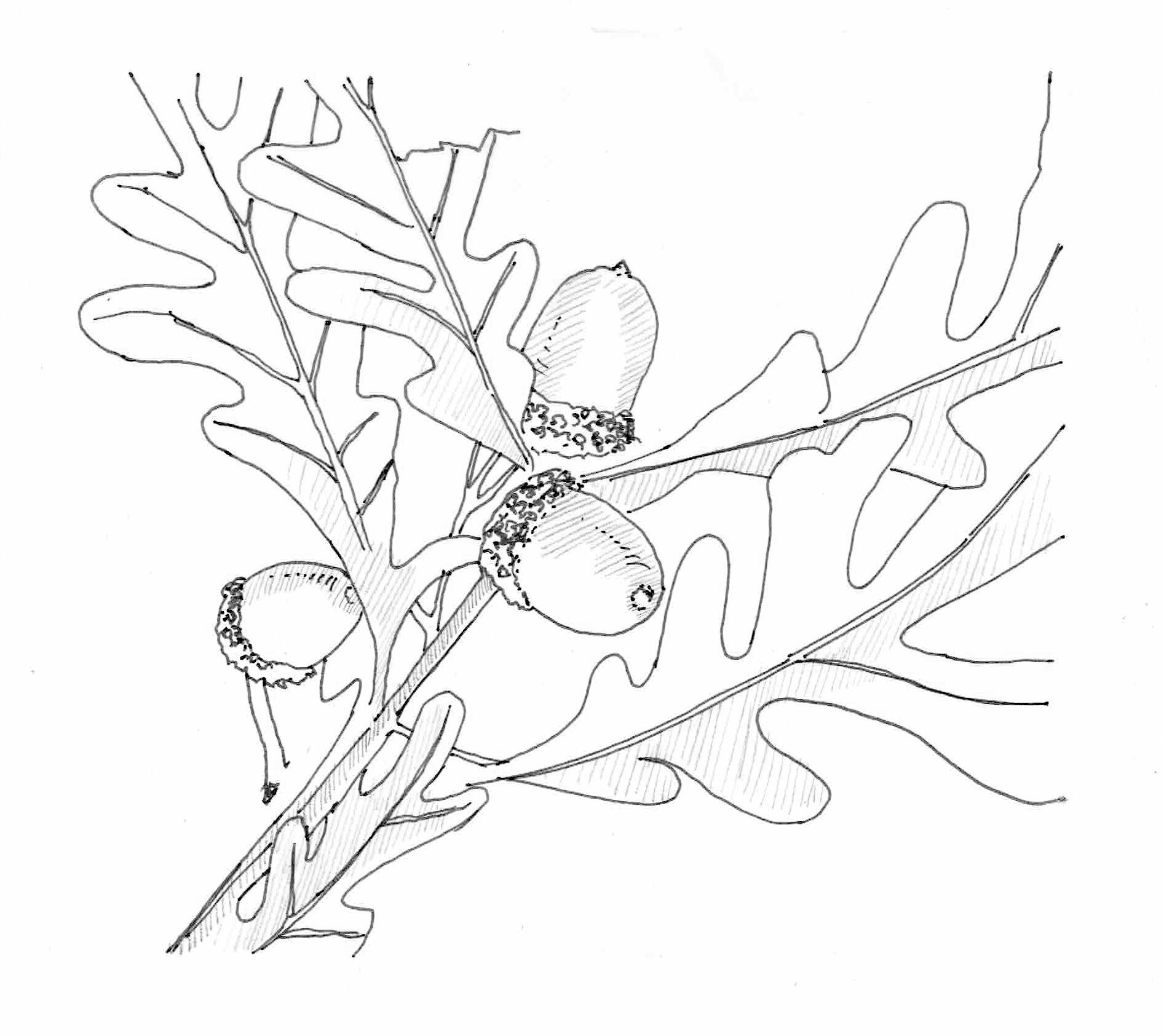Living Monuments: Keeping Time at Grandview
Battlefield
Given the layered nature of time, and memory, does how we remember history contribute to how we experience the present? The City of Hamilton is framed by two key cultural landscapes related to the War of 1812: Dundurn Park (Burlington Heights) and Battlefield National Historic Site. Heritage landscapes such as Battlefield Park are important cultural sites because they are places of remembrance.
Battlefields that shape historical events, such as the site of the Battle of Stoney Creek, are set aside to pay homage to history out of respect for human life, the value of triumph and the cost of loss. We remember these events and ascribe a monumentality to the place, often through a stone monument or a cultural marker. Yet, in setting these spaces aside, do we allow them to continue to have life and shape meaning? Through this exhibition, Monument Trees, asks citizens to question the nature of monuments and the idea of monumentality itself.
A monument is defined in the dictionary as "a statue, building, or other structure erected to commemorate a famous or notable person or event". Battlefield House Museum & Park, National Historic Site was created to recall the past and memorialize the battle that took place there. In considering the role that monuments play in the creation of culture, memory, identity and place, Monument Trees raise questions about ideas of 'monumentality' in civic life. Do monuments to history and time need to be stone? Does something with a monumental presence need to be manmade? And further, can a monumental figure be living? Is it cultural? Can a monument be a tree?
Time is memorialized through accumulation of earth and archived through sedimentation. Like a living scroll, layers of time are archived in the environment, remembered, and mediated by trees. Although battles are transient, in places around the world, trees remember events and retain memories in their internal structures. Tree rings can show the mark of a heavy year of rain, a year that was thin with drought and increased accumulation of carbon in the atmosphere. The rise of the industrial revolution, for example, can be observed in the rings of felled trees today. In taking the nature of human life into account, one can ask: what markers stand out as memorable? What clues does the landscape provide? How can we honour the impact that setting aside Battlefield Park has provided the wider community today?
In preserving the history of heritage landscapes, we gain something in return. Battlefield Park has inadvertently conserved an open green space in the East end of the city, serving as a connection point along a major urban stream corridor. A sub creek to the Red Hill Valley, Battlefield Creek flows from Billy Green Falls along the Niagara Escarpment, through a series of neighbourhood parks, and connects to the waterfront in Confederation Park. Along this stream course, many Monument Trees are preserved. Rehabilitating urban green spaces, such as Battlefield Creek, can serve to protect these monuments to natural history and make cities more livable.

How Old?
The White Oak
Common Name: White Oak
Scientific Name: Quercus alba
Approximate Age: ~305 years
Measurements: 51 inches in diameter


The Mountain
Tropos’ work explores how these narratives can expand to incorporate the natural environment as places of significance. Prior to the turn of the 19th century, many parts of downtown Hamilton were cleared for agricultural purposes before being turned over to early forms of urbanization. Today, Hamilton's heritage landscapes contain patches of our region's ancient urban forest. The Niagara Escarpment remains as a symbol of culture, identity and contributes powerfully to a sense of place in Southern Ontario. Many of Hamilton's heritage sites contain pre-settlement Monument Trees that weave in and out of these remnant forested landscapes. In the case of Battlefield Creek, elder trees growing along the creek bed pre-date the Battle of Stoney Creek and are older than the heritage site itself. Tucked behind the path along one of the entrances to the trails behind Battlefield Park, an older Sugar Maple remains.

The Monument

The Creek
To the East of Battlefield National Historic Site, Battlefield Creek defines the uneven edge of Battlefield Park. Watercourses, sedimentation, and time are defining features of our city. Old trees and old streams have a lot in common. They can often be found together. Trees need water, and places of abundant water supply can support higher numbers of trees. Remnant streams, especially those that run through historic landscapes, are valuable because they are already protected. Along Battlefield Creek, several two-hundred-year-old Swamp White Oak trees, Shagbark Hickories and Black Maple trees, among others, continue to grow. These native trees are part of the Carolinian life zone and have called Battlefield Creek home for over a century.
Battlefield Park Tree Species
- Bur Oak (Quercus macrocarpa)
- White Oak (Quercus alba)
- Black Walnut (Juglans nigra)
- Black Willow (Salix nigra)
- Swamp White Oak (Quercus bicolor)
- Black Maple (Acer nigrum)
- Sugar Maple (Acer saccharum)
An East-end Park - What If?
Battlefield Park sits at the mid-halfway point between the Niagara Escarpment and the waterfront. A series of parkland and open green area have been built around Battlefield Creek as it flows toward Confederation Park, before draining into remnant marshlands that were once connected to wetlands around the Hamilton Museum of Steam & Technology. Before urbanization, Hamilton was a fertile mosaic supported by an abundant supply of water. The lower city was forested, with open areas of Oak savanna and streams surrounded by wetlands. A sub creek to the Red Hill Valley, the greenspaces around Battlefield Creek are well situated to be reclaimed and transformed into a connected large-scale urban park, extending in a north-south direction.
At the North end of Battlefield Creek, a small pocket of thriving biodiversity can be found next to Barton Street East. This marsh is protected by the steep slopes around it and is reminiscent of the Cherry Hill Gate boardwalk trail at the Royal Botanical Gardens. Presently, a rough path winds through this landscape, which could be integrated through a boardwalk connection and link to Confederation Park.
Tropos’ research focuses on how natural systems can be integrated into the design of the city. Heritage landscapes such as Battlefield Park are important places because they are large, active green spaces. These environments can offset impacts of climate change that affect human health, such as heat island effect, flooding and poor air quality. Tropos’ studies show that Battlefield Park is uniquely positioned to become a new type of urban park in Hamilton's east end, connecting the Niagara Escarpment to the waterfront along the course of Battlefield Creek. What if Battlefield Creek became a new large-scale park? How would this support the wider community?
Explore Monument Trees In Your Classroom
Learning Link: https://www.troposltd.com/learn
Learning Resource - Seed School
White Oak (Quercus alba) is one of the longest-lived trees in our region. Some White Oaks have been known to live over 400 years if in the right environment. White Oak trees are unique because they produce both male and female flowers as part of their reproductive cycle. A White Oak acorn is oval and has a small cap. Unlike other species of oak trees, White Oak acorns are fruit from the fertilized female flower. Once a tree begins reproducing, they will produce acorns about every five to six years. Seed germination will occur as soon as an acorn hits the ground.
Despite this interlude, a single tree can produce thousands of acorns at a time. This is one of the primary reasons that White Oak trees are known for their high ecological and wildlife value. Many birds and animals rely on this high acorn production as part of their life cycle.


